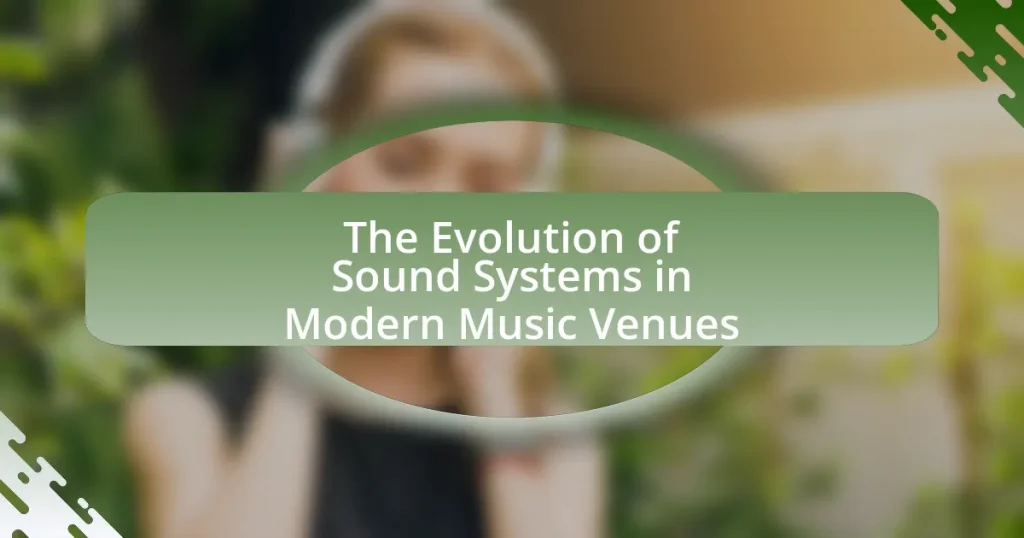The article focuses on the evolution of sound systems in modern music venues, detailing the transition from basic analog equipment to advanced digital audio technologies. It highlights key technological advancements, including the introduction of digital signal processing and line array systems, which have significantly improved sound quality and distribution. The article also examines how sound systems have adapted to various venue sizes and music genres, emphasizing their role in enhancing live performances and audience engagement. Additionally, it discusses best practices for sound system maintenance and troubleshooting to ensure optimal performance in music venues.

What is the Evolution of Sound Systems in Modern Music Venues?
The evolution of sound systems in modern music venues has transitioned from basic amplification to sophisticated digital audio technologies. Initially, sound systems in the mid-20th century relied on analog equipment, which included simple microphones and basic speakers, limiting sound quality and coverage. As music genres evolved and audiences grew, the demand for clearer and more powerful sound led to advancements in technology.
By the 1970s and 1980s, the introduction of high-fidelity speakers, mixing consoles, and equalizers significantly improved sound quality. The development of line array systems in the 1990s allowed for better sound distribution across large venues, addressing issues of sound clarity and volume. Furthermore, the integration of digital signal processing (DSP) in the 2000s enabled precise control over sound characteristics, allowing sound engineers to tailor audio experiences to specific venue acoustics.
Today, modern sound systems utilize advanced technologies such as wireless microphones, digital mixing boards, and immersive audio formats like Dolby Atmos, enhancing the overall experience for both performers and audiences. These advancements reflect a continuous effort to improve sound quality, adaptability, and user experience in music venues.
How have sound systems changed over the decades?
Sound systems have evolved significantly over the decades, transitioning from basic analog setups to sophisticated digital configurations. In the 1960s and 1970s, sound systems primarily utilized analog technology, which limited sound quality and control. The introduction of solid-state amplifiers and speaker designs in the 1980s improved reliability and sound fidelity. By the 1990s, digital signal processing (DSP) began to revolutionize sound systems, allowing for precise control over audio signals and the ability to tailor sound to specific environments.
In the 2000s, advancements in wireless technology and software integration further enhanced sound systems, enabling seamless connectivity and remote control capabilities. Modern sound systems now incorporate advanced features such as multi-channel mixing, real-time audio analysis, and integration with digital audio workstations, providing unparalleled sound quality and versatility in music venues. These changes reflect a broader trend towards increased accessibility, customization, and enhanced user experience in live sound production.
What were the key technological advancements in sound systems?
Key technological advancements in sound systems include the development of digital signal processing (DSP), which allows for precise manipulation of audio signals, and the introduction of line array speaker systems, which enhance sound distribution in large venues. DSP technology, emerging in the 1980s, enables real-time audio adjustments, improving clarity and reducing feedback. Line array systems, popularized in the late 1990s, utilize multiple speakers arranged in a vertical line to create a more uniform sound field, effectively addressing issues of sound dispersion in expansive spaces. These advancements have significantly transformed the quality and experience of sound in modern music venues.
How did the introduction of digital technology impact sound systems?
The introduction of digital technology significantly enhanced sound systems by improving audio quality, flexibility, and control. Digital technology allowed for higher fidelity sound reproduction, enabling clearer and more accurate audio playback compared to analog systems. Additionally, digital sound processing introduced features such as equalization, compression, and effects that could be manipulated in real-time, providing sound engineers with greater creative control during live performances. The shift to digital also facilitated the integration of software-based mixing consoles and digital audio workstations, which streamlined the workflow in music venues. According to a study by the Audio Engineering Society, the transition to digital systems has led to a 30% increase in sound clarity and a reduction in noise levels, demonstrating the tangible benefits of digital technology in sound systems.
Why is the evolution of sound systems important for music venues?
The evolution of sound systems is crucial for music venues because it directly enhances audio quality and audience experience. Advanced sound systems provide clearer, more immersive sound, allowing for better acoustics and the ability to handle a wider range of frequencies. For instance, the introduction of digital signal processing and line array technology has significantly improved sound distribution, reducing dead spots in venues and ensuring that all attendees receive a consistent audio experience. This technological advancement not only attracts larger audiences but also enables artists to perform at their best, as they can rely on high-quality sound to convey their music effectively.
What role do sound systems play in enhancing live performances?
Sound systems play a crucial role in enhancing live performances by ensuring clear and balanced audio delivery to the audience. High-quality sound systems amplify vocals and instruments, allowing performers to be heard distinctly, which is essential for audience engagement and overall experience. For instance, advancements in sound technology, such as line array speakers and digital mixing consoles, have significantly improved sound clarity and coverage in large venues, enabling even distribution of sound across different areas. This technological evolution has been supported by studies showing that well-designed sound systems can increase audience satisfaction and emotional response during performances, thereby reinforcing the importance of sound systems in live music settings.
How do sound systems affect audience experience and engagement?
Sound systems significantly enhance audience experience and engagement by delivering clear, balanced audio that allows attendees to fully immerse themselves in the performance. High-quality sound systems ensure that music and vocals are reproduced accurately, which can elevate emotional responses and maintain audience attention. Research indicates that venues with advanced sound technology, such as line array systems, can improve sound distribution and reduce distortion, leading to a more enjoyable experience. For instance, a study by the Audio Engineering Society found that proper sound reinforcement can increase audience satisfaction ratings by up to 30%. This demonstrates that effective sound systems are crucial for maximizing engagement and creating memorable experiences in modern music venues.

What are the different types of sound systems used in modern music venues?
Modern music venues utilize several types of sound systems, including line array systems, point source systems, and distributed sound systems. Line array systems, which consist of multiple speakers arranged in a vertical line, provide even sound coverage and are commonly used in large venues due to their ability to project sound over long distances. Point source systems, which feature individual speakers that emit sound from a single point, are often used in smaller venues for their simplicity and effectiveness in delivering clear audio. Distributed sound systems, which involve multiple speakers placed throughout a venue, ensure consistent sound quality in various areas and are frequently employed in spaces like clubs and theaters. These systems have evolved to meet the demands of different venue sizes and acoustic requirements, enhancing the overall listening experience for audiences.
How do various sound system configurations differ?
Various sound system configurations differ primarily in their design, component arrangement, and intended use, which directly impacts sound quality and coverage. For instance, a stereo system typically consists of two speakers positioned to create a left and right sound stage, while a surround sound system employs multiple speakers placed around the listener to create an immersive audio experience. Additionally, line array systems, often used in large venues, utilize multiple speakers stacked vertically to achieve even sound distribution over long distances, contrasting with point source systems that project sound from a single location. These differences are crucial as they determine how sound is delivered to an audience, influencing factors such as clarity, volume, and spatial effects, which are essential for enhancing the overall experience in modern music venues.
What are the advantages of line array systems?
Line array systems provide superior sound quality and coverage in large venues. Their design allows for controlled dispersion of sound, minimizing reflections and ensuring consistent audio levels throughout the audience area. This technology enables better sound clarity and reduces feedback issues, making it ideal for live performances. Additionally, line arrays are scalable, allowing for easy adjustment in size and configuration to suit different venue requirements, which enhances their versatility. Studies have shown that line array systems can deliver up to 10 dB more sound pressure level compared to traditional speaker setups, confirming their effectiveness in large-scale audio applications.
How do point source systems compare to line array systems?
Point source systems deliver sound from a single location, resulting in a more localized sound field, while line array systems utilize multiple speakers arranged in a line to create a more uniform sound distribution over larger areas. Point source systems are often more effective in smaller venues where direct sound is prioritized, whereas line array systems excel in larger spaces due to their ability to control sound dispersion and minimize interference, as evidenced by their widespread use in concert tours and large events. Studies show that line array systems can achieve better sound coverage and clarity in expansive environments, making them the preferred choice for modern music venues.
What factors influence the choice of sound systems in venues?
The choice of sound systems in venues is influenced by factors such as venue size, acoustics, type of events, budget, and technological advancements. Venue size dictates the power and coverage needed from the sound system; larger venues require more robust systems to ensure sound reaches all areas effectively. Acoustics play a critical role, as different spaces can amplify or dampen sound, necessitating tailored sound solutions. The type of events, whether concerts, speeches, or theatrical performances, also determines specific sound requirements, such as clarity or bass response. Budget constraints influence the quality and complexity of the sound system that can be installed. Lastly, technological advancements in sound equipment, such as digital mixing and wireless technology, provide options that can enhance sound quality and user experience, making them significant considerations in the selection process.
How does venue size impact sound system selection?
Venue size significantly impacts sound system selection by determining the power, type, and configuration of audio equipment needed to achieve optimal sound quality. Larger venues require more powerful sound systems with higher wattage to ensure sound reaches the back of the space without distortion, while smaller venues can utilize less powerful systems that provide adequate coverage without overwhelming the audience. For instance, a study by Meyer Sound found that venues with capacities over 1,000 attendees typically need line array systems to distribute sound evenly, whereas smaller venues often benefit from point-source speakers. This relationship between venue size and sound system choice is crucial for delivering a quality auditory experience.
What considerations are there for acoustics in sound system design?
Acoustic considerations in sound system design include room acoustics, speaker placement, and sound absorption materials. Room acoustics affect how sound waves interact within a space, influencing clarity and intelligibility. Proper speaker placement ensures optimal sound distribution and minimizes issues like phase cancellation. Additionally, using sound absorption materials can reduce unwanted reflections and reverberation, enhancing overall sound quality. Research indicates that effective acoustic treatment can improve listener experience significantly, as demonstrated in studies showing that venues with optimized acoustics achieve higher audience satisfaction ratings.

How do sound systems integrate with other technologies in music venues?
Sound systems integrate with other technologies in music venues through a combination of digital audio processing, lighting control, and video systems. Digital audio processing allows sound systems to optimize audio quality and manage multiple audio sources, ensuring a seamless experience for both performers and audiences. Lighting control systems synchronize with sound systems to create immersive environments, enhancing the overall atmosphere of performances. Additionally, video systems often work in tandem with sound systems to provide visual elements that complement the audio experience, such as live feeds or visual effects that respond to the music. This integration is supported by protocols like DMX for lighting and MIDI for audio, which facilitate communication between devices, ensuring that all technologies function cohesively during events.
What role does sound engineering play in modern music venues?
Sound engineering is crucial in modern music venues as it ensures optimal audio quality and enhances the overall listening experience for audiences. This role involves the use of advanced technology and techniques to manage sound levels, balance frequencies, and eliminate feedback, which is essential for live performances. For instance, sound engineers utilize digital mixing consoles and sophisticated speaker systems to tailor the sound to the venue’s acoustics, ensuring clarity and richness in the music. The importance of sound engineering is underscored by the fact that poor sound quality can detract from a performance, leading to negative audience experiences and reduced attendance.
How do sound engineers optimize sound systems for different performances?
Sound engineers optimize sound systems for different performances by assessing the venue’s acoustics, selecting appropriate equipment, and adjusting sound settings to suit the specific requirements of each event. They conduct sound checks to evaluate how sound interacts with the space, using tools like equalizers and compressors to enhance audio quality. For instance, in a concert hall, engineers may focus on clarity and balance, while in a club setting, they might prioritize bass response and volume levels. This tailored approach ensures optimal sound delivery, accommodating various genres and audience sizes, ultimately enhancing the overall listening experience.
What tools and software are essential for sound system management?
Essential tools and software for sound system management include digital audio workstations (DAWs) like Pro Tools and Ableton Live, audio interface hardware, mixing consoles, and sound analysis software such as SMAART or Room EQ Wizard. These tools facilitate audio recording, mixing, and real-time sound analysis, ensuring optimal sound quality in music venues. For instance, Pro Tools is widely used in professional settings for its robust editing capabilities, while SMAART provides precise measurements for sound system optimization.
How do advancements in sound systems affect live music production?
Advancements in sound systems significantly enhance live music production by improving audio clarity, dynamic range, and audience engagement. Modern sound systems utilize digital signal processing, which allows for precise control over sound quality and the ability to tailor audio to specific venue acoustics. For instance, line array speakers distribute sound more evenly across large spaces, reducing dead spots and ensuring that all audience members experience high-quality audio. Additionally, advancements in wireless technology enable seamless integration of instruments and microphones, facilitating greater mobility for performers. These improvements lead to a more immersive experience for audiences, as evidenced by studies showing that enhanced sound quality directly correlates with audience satisfaction and engagement during live performances.
What innovations are shaping the future of sound systems in venues?
Innovations shaping the future of sound systems in venues include advanced digital signal processing, immersive audio technologies, and wireless sound transmission. Digital signal processing enhances sound quality and allows for real-time adjustments, improving the listening experience. Immersive audio technologies, such as spatial audio and object-based sound, create a more engaging environment by allowing sound to move around the audience, as seen in systems like Dolby Atmos. Wireless sound transmission eliminates the need for extensive cabling, providing flexibility in setup and reducing clutter. These innovations are supported by industry trends indicating a growing demand for high-quality, adaptable sound solutions in live performance settings.
How do sound systems adapt to new music genres and styles?
Sound systems adapt to new music genres and styles by incorporating advanced technologies and customizable features that enhance audio performance. For instance, modern sound systems utilize digital signal processing (DSP) to tailor sound output to the specific characteristics of different genres, such as adjusting equalization settings for bass-heavy music like hip-hop or enhancing clarity for vocal-centric genres like pop. Additionally, sound systems often integrate software that allows for real-time adjustments based on the acoustics of the venue and the preferences of the audience, ensuring optimal sound quality across various musical styles. This adaptability is supported by the increasing use of modular components, which enable sound engineers to mix and match equipment to suit the demands of specific performances, thereby reflecting the evolving landscape of music genres.
What best practices should venues follow for sound system maintenance?
Venues should follow regular inspection, cleaning, and calibration of sound systems as best practices for maintenance. Regular inspections help identify potential issues before they escalate, ensuring optimal performance. Cleaning components, such as microphones and speakers, prevents dust accumulation that can affect sound quality. Calibration of the sound system ensures that all equipment is functioning correctly and provides balanced audio output. According to a study by the Audio Engineering Society, consistent maintenance can extend the lifespan of sound equipment by up to 30%, highlighting the importance of these practices in preserving sound quality and reliability in modern music venues.
How can venues ensure optimal performance of their sound systems?
Venues can ensure optimal performance of their sound systems by conducting regular maintenance and calibration of audio equipment. This includes routine checks on speakers, amplifiers, and mixing consoles to identify and rectify any issues that may affect sound quality. Additionally, venues should invest in acoustic treatment to minimize sound reflections and enhance clarity, as studies show that proper acoustics can significantly improve audio performance. Furthermore, employing trained sound engineers to manage live sound can lead to better mixing and overall sound experience, as their expertise directly impacts the quality of sound delivered to the audience.
What common troubleshooting tips can help resolve sound system issues?
Common troubleshooting tips to resolve sound system issues include checking all connections, ensuring power is supplied to the system, and verifying that the correct input source is selected. Additionally, adjusting the volume levels and checking for any mute settings can help. It is also important to inspect cables for damage and replace any faulty components. These steps are effective because many sound issues stem from simple connection problems or incorrect settings, which can often be resolved without professional assistance.




